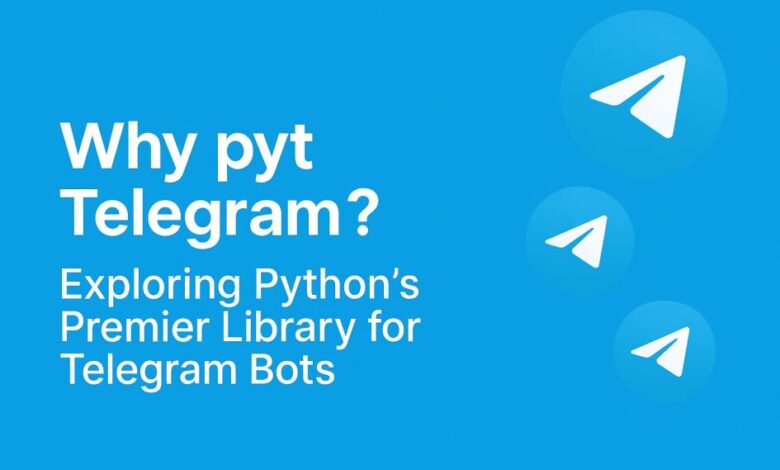
Why pyt Telegram? Exploring Python’s Premier Library for Telegram Bots
Creating a Telegram bot can feel like venturing into uncharted waters-there are so many libraries, frameworks, and API wrappers out there that it’s hard to know which one to trust. If you’re a Python developer looking to build anything from a simple notification bot to a fully featured conversational agent, pyt telegram stands head and shoulders above the rest. In this article, we’ll explore why pyt telegram has rapidly become the go‑to choice for bot builders around the world. You’ll learn what makes it unique, how to get started, and best practices for taking your bot from prototype to production.
What Is pyt Telegram? An Overview of Python’s Premier Telegram API Wrapper
At its core, pyt telegram is a Python library that provides a convenient, Pythonic interface to the official Telegram Bot API. Rather than dealing with raw HTTP requests and JSON payloads, Pyt Telegram lets you work with familiar Python objects and idioms. It handles serialization and deserialization for you, supports both synchronous and asynchronous programming styles, and offers built‑in helpers for common tasks like setting up webhooks or long‑polling loops.
Originally released in 2020 by an open‑source contributor, Pyt Telegram has grown under active community stewardship. Today, it boasts:
- Consistent type hints that integrate seamlessly with modern IDEs and linters.
- Minimal external dependencies, reducing potential version conflicts.
- Built‑in middleware support for filtering and routing updates.
- Extensible plugin system that allows developers to share reusable handlers and utilities.
Together, these features make pyt telegram a robust, professional‑grade library for any scale of Telegram bot project.
Key Features That Make Pyt Telegram a Go‑To Library
Below are the standout capabilities that set Pyt Telegram apart:
- Async‑First Architecture
Designed around Python’s asyncio from day one, you can write non‑blocking code that scales effortlessly when handling thousands of concurrent users or commands.
- Comprehensive Type Hinting & Data Models
Every API response and request comes with full-type annotations. This not only improves editor autocomplete but also helps catch errors at development time rather than runtime.
- Automatic Payload Validation
The library validates required fields before sending requests. If you forget to include a chat_id, Pyt telegram will raise a clear, descriptive error instead of leaving you to debug obscure API failures.
- Elegant Handler Registration
Use decorators to hook into message events, callback queries, inline queries, and more. Handlers can include filters for text patterns, command names, user roles, or complex predicates.
- Middleware Support
Insert reusable logic—such as logging, rate limiting, or authentication—into the update processing pipeline without cluttering your business code.
- Webhook & Long Polling Made Simple
Whether you prefer setting up a webhook endpoint on your own server or running a polling loop on a hosted function, Pyt telegram provides straightforward abstractions for both approaches.
- Rich Media Utilities
From sending photos, videos, and documents to streaming large audio files, the library handles chunked uploads, progress reporting, and media grouping seamlessly.
- Plugin Ecosystem
Discover community‑maintained plugins for analytics, database integration, state management, and more. The plugin system allows you to plug in new behavior without modifying your core bot code.
Getting Started with Pyt Telegram
Let’s get your first bot up and running in minutes.
Prerequisites and Environment Setup
1. Python 3.8+
Ensure you have Python 3.8 or newer installed. Check with:
bash
python3 –version
2. Virtual Environment
It’s best practice to isolate dependencies. Create and activate one:
bash
python3 -m venv venv
source venv/bin/activate
3. Obtain a Bot Token
Message BotFather on Telegram and create a new bot. Copy the API token you receive.
Installing Pyt Telegram via pip
With your environment active, install Pyt telegram:
bash
pip install pyt-telegram
Your First “Hello, World!” Bot
Create bot.py with:
python
import asyncio
from pyt_telegram import Bot, Dispatcher, types
API_TOKEN = “YOUR_BOT_TOKEN_HERE”
async def start_command(update: types.Update, context: types.Context):
await update.message.reply_text(“Hello, world! I’m powered by pyt-telegram.”)
async def main():
bot = Bot(token=API_TOKEN)
dp = Dispatcher(bot)
dp.add_handler(types.CommandHandler(“start”, start_command))
# Choose polling (for development) or webhook (for production)
await dp.start_polling()
await dp.idle()
if __name__ == “__main__”:
asyncio.run(main())
Run it:
bash
python bot.py
Send /start to your bot, and it replies with Hello, world! I’m powered by pyt-telegram.
Leveraging Advanced pyt Telegram Functionality
Inline Keyboards & Callback Queries
Inline keyboards let you present buttons directly under messages. Define them like so:
python
from pyt_telegram import types
inline_kb = types.InlineKeyboardMarkup(
inline_keyboard=[
[types.InlineKeyboardButton(text=“Yes”, callback_data=“yes”)],
[types.InlineKeyboardButton(text=“No”, callback_data=“no”)],
]
)
Handle presses with:
python
async def button_handler(update: types.Update, context: types.Context):
query = update.callback_query
await query.answer()
await query.edit_message_text(f”You clicked: {query.data}“)
dp.add_handler(types.CallbackQueryHandler(button_handler))
Webhook vs. Long Polling
- Long Polling: Ideal for local development and small‑scale bots.
- Webhooks: Preferred in production—Telegram pushes updates to your HTTPS endpoint, reducing latency.
Switch in code by calling:
python
await dp.start_webhook(
listen=“0.0.0.0”,
port=8443,
webhook_url=“https://yourdomain.com/webhook”
)
File Uploads, Media Groups & Stickers
Send photos:
python
await bot . send _ photo (chat_id=12345, photo=open(“image.jpg”, “rb”))
Create an album:
python
media = [
types.InputMediaPhoto(open(“img1.jpg”, “rb”)),
types.InputMediaPhoto(open(“img2.jpg”, “rb”)),
]
await bot.send_media_group(chat_id=12345, media=media)
Stickers work similarly with send_sticker.
Real‑World Use Cases: What You Can Build with Pyt Telegram
- Customer Support Chatbot: Automate FAQs, escalate to human agents and log conversations.
- Notification & Alert System: Deliver real‑time alerts—server health checks, stock price movements, and more.
- Interactive Group Management: Issue polls, quizzes, or timed announcements with minimal code.
- E‑commerce Order Tracker: Provide customers with order status updates directly in Telegram.
- Game & Trivia Bot: Host live trivia, track scores, and manage leaderboards.
- Content Distribution Bot: Push blog posts, news summaries, or marketing campaigns to subscribers.
Each of these scenarios benefits from Pyt Telegram’s event handling, media support, and middleware capabilities.
Best Practices for Pyt Telegram Development
- Modularize Your Code: Organize handlers, filters, and utilities into separate modules.
- Use Environment Variables: Load secrets securely; never hard‑code your token.
- Implement Logging: Configure Python’s logging module for clear runtime insights.
- Rate‑Limit Management: Honor Telegram’s limits by catching RetryAfter exceptions and backing off.
- Testing & CI: Write unit tests for handlers; run tests and lint checks on every push.
- Version Pinning: Freeze dependencies in requirements.txt to avoid unexpected upgrades.
- Graceful Shutdown: Handle termination signals to clean up resources and save state.
Security Considerations When Building with pyt Telegram
- Protect Your Bot Token: Store it securely, never in public code.
- Validate Webhook Requests: Confirm requests originate from Telegram by checking headers or IP ranges.
- Sanitize User Input: Escape potentially malicious characters before rendering Markdown or HTML.
- Limit Access: Restrict sensitive commands to approved user IDs or group chats.
- Keep Dependencies Updated: Regularly audit for known vulnerabilities.
Troubleshooting Common Pyt Telegram Errors
- NetworkError / TimeoutError: Often transient—implement exponential backoff.
- Unauthorized: Token invalid or revoked—verify environment loading or regenerate the token.
- BadRequest: Malformed parameters—inspect exception messages for clues.
- Conflict: Webhook conflict—remove the old webhook or switch to polling.
- RetryAfter: Rate limiting—honor the retry_after before retrying.
Enable DEBUG‑level logging for full request/response traces when diagnosing tricky issues.
Deploying Your Pyt Telegram Bot to Production
- Choose a Hosting Platform: Heroku for small bots, AWS Lambda for serverless, or a VPS for full control.
- Dockerize Your Bot: Use a simple Dockerfile to containerize your application.
- CI/CD Pipeline: Automate tests, linting, and deployments with your preferred CI service.
- Monitoring & Alerts: Integrate error tracking (e.g., Sentry) and uptime checks to keep your bot running smoothly.
Conclusion:
From beginner “hello world” bots to mission‑critical production systems, Pyt Telegram delivers the features, performance, and extensibility you need. Its async‑first design, rich type support, and active plugin ecosystem make it the premier choice for Python developers building on Telegram’s Bot API. Whether you’re automating customer support, sending real‑time alerts, or crafting the next viral chatbot, pyt telegram provides a stable, well‑maintained foundation to bring your ideas to life in 2025 and beyond.





